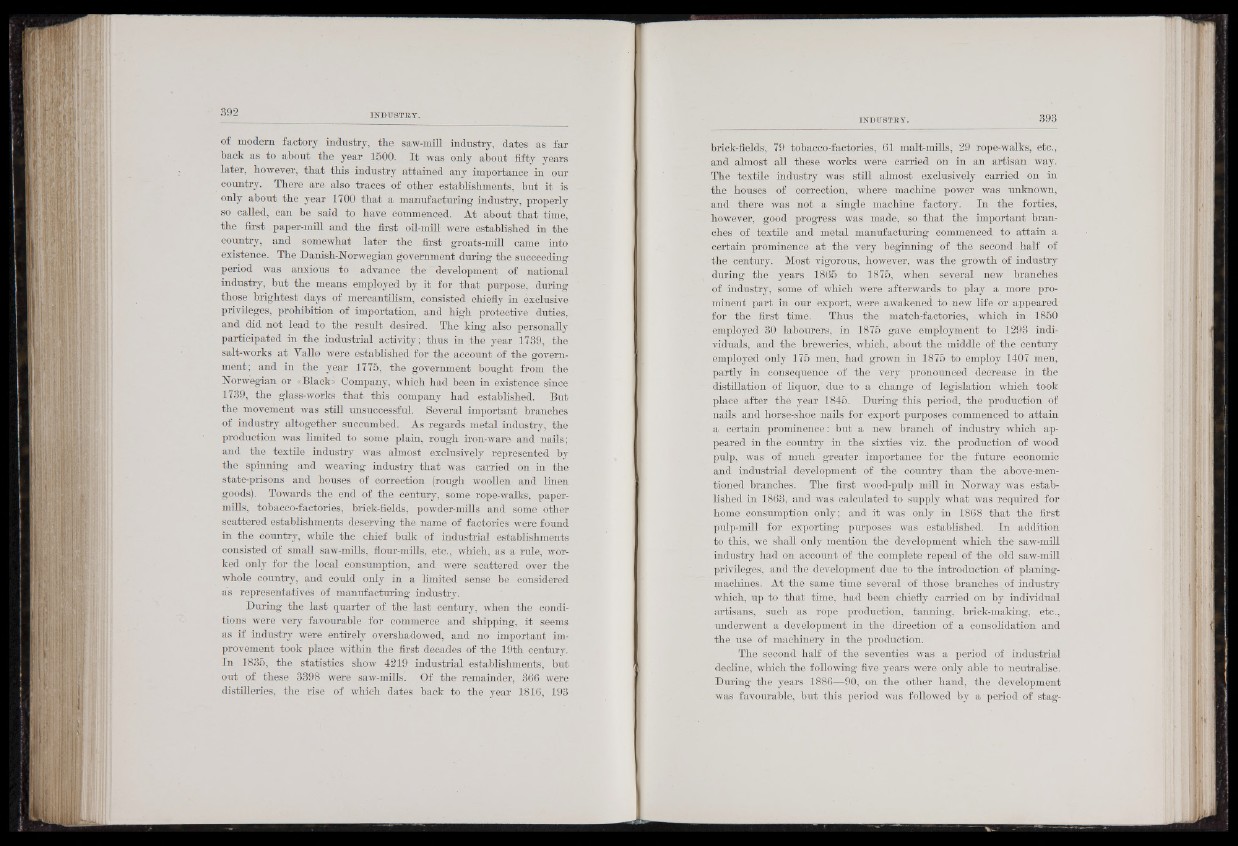
of modern factory industry, the saw-mill industry, dates as far
back as to about the year 1500. I t was only about fifty years
later, however, that this industry attained any importance in our
country. There are also traces of other establishments, but it is
only about the year 1700 that a manufacturing industry, properly
so called, can he said to have commenced. At about that time,
the first paper-mill and the first oil-mill were established in the
country, and somewhat later the first groats-mill came into
existence. The Danish-Norwegian government during the succeeding
period was anxious to advance the development of national
industry, but the means employed by it for that purpose, during
those brightest days of mercantilism, consisted chiefly in exclusive
privileges, prohibition of importation, and high protective- duties,
and did not lead to the result desired. The king also personally
participated in the industrial activity; thus in the year 1739, the
salt-works at Vallo were established for the account of the government;
and in the year 1775, the government bought from the
Norwegian or «Black» Company, which had been in existence since
1739, the glass-works that this company had established. But
the movement was still unsuccessful. Several important branches
of industry altogether succumbed. As regards metal industry, the
production was limited to some plain, rough iron-ware and nails;
and the textile industry was almost exclusively represented by
the spinning and weaving industry that was carried on in the
state-prisons and houses of correction (rough woollen and linen
goods). Towards the end of the century, some rope-walks, paper-
mills, tobacco-factories, brick-fields, powder-mills and some other
scattered establishments deserving the name of factories were found
in the country, while the chief bulk of industrial establishments
consisted of small saw-mills, flour-mills, etc., which, as a rule, worked
only for the local consumption, and were scattered over the
whole country, and could only in a limited sense be considered
as representatives of manufacturing industry.
During the last quarter of the last century, when the conditions
were very favourable for commerce and shipping, it seems
as if industry were entirely overshadowed, and no important improvement
took place within the first decades of the 19th century.
In 1835, the statistics show 4219 industrial establishments, but
out of these 3398 were saw-mills. Of the remainder, 366 were
distilleries, the rise of which dates back to the year 1816, 193
brick-fields, 79 tobacco-factories, 61 malt-mills, 29 rope-walks, etc.,
and almost all these works were carried on in an artisan way.
The textile industry was still almost exclusively carried on in
the houses of correction, where machine power was unknown,
and there was not a single machine factory. In the forties,
however, good progress was made, so that the important branches
of textile and metal manufacturing commenced to attain a
certain prominence at the very beginning of the second half of
the century. Most vigorous, however, was the growth of industry
during the ..years 1865 to 1875, when several new branches
of industry, some of which were afterwards to play a more prominent
part in our export, were awakened to new life or appeared
for the first time. Thus the match-factories, which in 1850
employed 30 labourers, in 1875 gave employment to 1293 individuals,
and the breweries, which, about the middle of the century
employed only 175 men, had grown in 1875 to employ 1407 men,
partly in consequence of the very pronounced decrease in the
distillation of liquor,' due to a change of legislation which took
place after the year 1845. During this period, the production of
nails and horse-shoe nails for export purposes commenced to attain
a certain prominence : but a new branch of industry which appeared
in the country in the sixties viz. the production of wood
pulp, was of much greater, importance for the future economic
and industrial development of the country than the above-mentioned
branches. The first wood-pulp mill in Norway was established
in 1863, and was calculated to supply what was required for
home consumption only ; and it was only in 1868 that the first
pulp-mill for exporting purposes was established. In addition
to this, we shall only mention the development which the saw-mill
industry had on account of the complete repeal of the old saw-mill
privileges, and the development due to the introduction of planing-
machines. , At the same time several of those branchesViof industry
which, up to that time, had been. chiefly carried on by individual
artisans, such as rope production, tanning, brick-making, etc.,
underwent a development in the direction of a consolidation and
the use of machinery in the production.
The second half of the seventies was a period of industrial
decline, which the following five years were only able to neutralise.
During the years 1886—90, on the other hand, the development
was favourable, but this period was followed by a period of stag